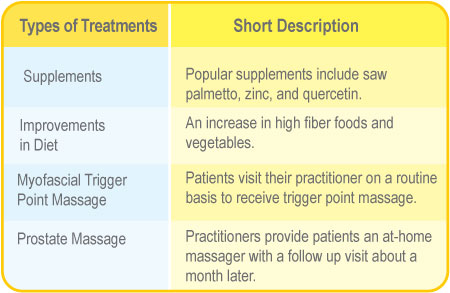The Centers for Disease Control (CDC) estimates that 50 of men will experience prostate problems during their lifetime.1 Despite this prevalence, prostate problems are one of the least addressed and talked about issues. Besides a man’s annual visit to the urologist, few practitioners discuss the prostate with their patients, even though it is central to a man’s well being.
Many organizations have attempted to address this issue, often unsuccessfully. However, in 1999, the American Urological Association (AUA) officially designated September as Prostate Health Month2 as an effort to make the public more aware of prostate health problems. This mission is ongoing, yet it still lags behind many other worthy causes, such as breast cancer awareness.
Why Should You Care?
There are several important reasons why practitioners, especially chiropractors, should care about prostate health. First, given the extremely high prevalence of prostate problems, i.e., one in every two men, it is almost guaranteed many patients that a practitioner treats will have or develop prostate problems. Practitioners can increase awareness of prostate issues and seize an opportunity to help patients by directly addressing and discussing prostate health, symptoms, and treatments.
Second, the current traditional treatments available are often ineffective and/or invasive. When men who have prostate problems, such as prostatitis, visit their physicians, more than 90 percent are prescribed antibiotics, even though their diagnosis is nonbacterial.3 Not surprisingly, the antibiotics are effective in less than 30 percent of cases.4 Other standard treatments, such as surgery, radiation, and hormone therapy, are invasive, are of limited effectiveness, and can have major side effects, such as incontinence and impotence, which occurs in about 65 percent of cases.5
Lastly, recent research shows that a great number of prostate problems are not necessarily centered specifically on the prostate.6 Chronic prostatitis is now synonymous with chronic pelvic pain, indicating that non-bacterial prostatitis is associated with poor musculature, stress, and anxiety.7 Therefore, new therapies, such as trigger point therapy and prostate massage, are increasingly utilized rather than less effective traditional antibiotic or surgical treatments.
Ways to Contribute—Alternative Treatment Options:
Research has proven that minimally invasive treatments for prostate problems can be safe and effective.8 These treatments can be appropriate for patients who want to avoid a lifetime of daily medications, the risks of invasive surgery, and the side effects associated with many standard options.
Several non-invasive treatments that a practitioner can recommend are worth discussing. The most common non-medicinal treatment is supplements. Supplements include anything from saw palmetto to zinc and, most recently, quercetin, a plant pigment found in some fruits, vegetables, and teas.9 Numerous supplements exist that will contain these substances, some of which have been clinically tested for effectiveness.

As prostate disease is sometimes referred to as a nutritional disease, changes in diet and food intake can have profound effects. A typical Western diet is higher in fat, involves more animal derived foods, and the association of prostate disease is significantly higher than for Asian/Eastern diets.10 Altering a patient’s diet to include more fiber and vegetables can significantly help decrease a patient’s prostate problems and can also serve as an effective preventative approach.11
Lastly, two increasingly popular and scientifically backed methods that are in line with chiropractic practice are worth mentioning in more detail. First, trigger point therapy of key areas related to pelvic health and the perineum is an effective means of treating chronic pelvic pain. Patients receive repeated sessions of trigger point therapy for a practitioner-specified period of time. Patients also report to their practitioners for routine monitoring of their condition.12
Second, direct massage of the prostate, whether with the help of a practitioner or, more simply, by use of a prostate massage device, has also proven to be effective. Prostate massage with a prostate massager has several advantages. The prostate massager addresses prostate problems directly at the source. Also, a prostate massager that a patient can use on his own eliminates the need for in-office massage. The practitioner simply provides the massager to the patient and assesses the patient’s progress about a month later. With an 80 percent effectiveness rate and years of safety history, prostate massage with a massager is an easy, safe, and effective treatment worth recommending.13
There are over 147.5 million men in the US, half of which will experience prostate problems at some point in their life.14 Practitioners can contribute to their patients’ prostate health by discussing prostate issues with their patients, incorporating some of the treatments mentioned above, and encouraging patients to get an annual exam. Patients turn to chiropractors for the latest treatments; therefore, chiropractors are in a special position to make a difference in spreading the word about prostate health.
Myrenda Chiu, J.D., is an advocate of prostate health and awareness. She is also the Managing  Director at High Island Health, an alternative medicine company, producing the world’s first and only patented, physician endorsed prostate massager. High Island Health dedicates its resources to the education, research, and development of innovative alternatives for ailments of the lower body. For more information, visit www.highisland.com or call 1-713-680-8840
Director at High Island Health, an alternative medicine company, producing the world’s first and only patented, physician endorsed prostate massager. High Island Health dedicates its resources to the education, research, and development of innovative alternatives for ailments of the lower body. For more information, visit www.highisland.com or call 1-713-680-8840
